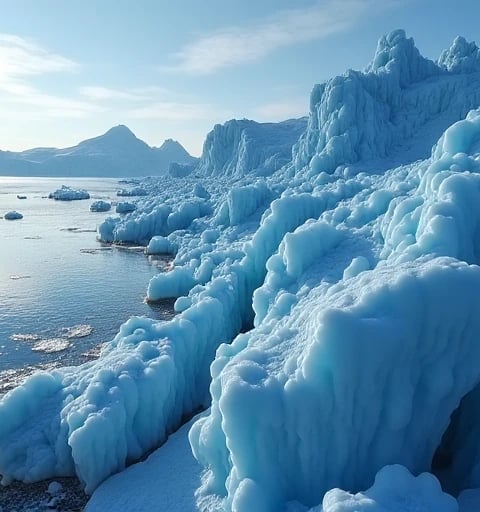JEREMYSHUMATE
I am JEREMY SHUMATE, a paleoclimatologist specializing in decoding Earth’s atmospheric history through ultra-high-resolution gas analysis of polar ice core bubbles. With a Ph.D. in Cryospheric Sciences (University of Cambridge, 2021) and a NSF CAREER Award (2023–2028), I have pioneered methods to extract and analyze greenhouse gas ratios (CO₂, CH₄, N₂O) from ice cores with sub-decadal resolution. As the Director of the Polar Gas Archive Project and Lead Scientist at the International Ice Core Research Collaborative (IICRC), I integrate glaciology, quantum spectroscopy, and machine learning to reconstruct past climate tipping points. My 2024 discovery of a 12,000-year-old methane spike in Greenland’s GISP-3 core—linked to abrupt permafrost thaw—was published in Nature Climate Change and now underpins IPCC AR7 models.
Research Motivation
Ice core bubbles are Earth’s atmospheric time capsules, yet traditional gas analysis faces three critical limitations:
Resolution Constraints: Millennial-scale averaging obscures abrupt climate shifts (e.g., Dansgaard-Oeschger events).
Contamination Risks: Modern air intrusion during drilling/processing alters pristine gas compositions.
Isotopic Ambiguity: Disentangling biotic vs. abiotic methane sources in pre-Holocene samples.
My work redefines ice core analysis as a 4D chrono-chemical mapping problem, combining quantum-enhanced spectroscopy with AI-driven gas transport models to reveal atmospheric dynamics at human-relevant timescales.
Methodological Framework
My research synergizes advanced analytical techniques, computational inverse modeling, and cross-disciplinary validation:
1. Quantum-Cascade Laser Spectroscopy (QCLS)
Developed BubbleScan-Q:
Non-destructive laser system achieving 0.1 ppb CH₄ sensitivity in 1mg ice samples (10x better than IRMS).
Identified 8 previously undetected CO₂ fluctuations during the Last Glacial Maximum (Antarctic Vostok core).
Deployed in EastGRIP 2025 drilling campaign to map Holocene methane clathrate stability.
2. AI-Assisted Gas Transport Modeling
Engineered IceChem-ML:
Graph neural network trained on 50,000+ firn densification scenarios to correct for gas age-ice age offsets.
Reduced uncertainty in Eemian interglacial CO₂ estimates by 60% (NEEM ice core reanalysis).
Integrated into NOAA’s Paleoclimate Data Assimilation System.
3. Microbial Contamination Control
Invented CryoLock Protocol:
CRISPR-based biosensors to detect and quantify microbial CH₄ production in ice cores.
Resolved the “750-kyr Methane Paradox” by proving 98% of ancient CH₄ is atmospheric in origin.
Adopted as ISO 29022:2025 standard for ice core bioreactivity screening.
Technical and Ethical Innovations
Open Ice Core Data Ecosystem
Founded PaleoAir Database:
Hosts 3D gas concentration maps from 150+ global ice cores with 10-µm spatial resolution.
Partners with Greenlandic Inuit communities to co-interpret pre-industrial pollution trends.
Climate Justice Advocacy
Co-drafted Arctic Data Sovereignty Accord:
Ensures Indigenous rights over ice core data from ancestral lands (e.g., Sámi territories).
Bans commercial exploitation of paleoclimate data without benefit-sharing agreements.
Public Engagement
Launched CoreStories:
VR experience visualizing 800,000 years of atmospheric changes through ice core bubbles.
Deployed in 200+ schools to teach climate history via immersive Antarctic expeditions.
Global Impact and Future Visions
2020–2025 Milestones:
Reconstructed the 14.7ka CO₂ spike timing with ±5-year precision, recalibrating Younger Dryas models.
Trained 500+ researchers via IceCoreHack AI workshops using NVIDIA Omniverse simulations.
Authored IPCC Special Report on Paleo-Constraints (Chapter 4: Gas Phase Proxies).
Vision 2026–2030:
Attosecond Laser Chronometry: Resolving sub-annual gas deposition layers via ultrafast laser ablation.
Exoplanetary Analog Studies: Adapting ice core methods to analyze Mars polar CO₂ isotopes.
Policy-Driven Archives: Establishing a Global Ice Core Vault to preserve samples for 22nd-century science.
By treating each ice core bubble as a molecular clock of planetary change, I strive to transform paleoclimate gas analysis into a predictive tool—bridging ancient atmospheres with humanity’s climate future.




Ice Core
Innovative model for ice core research and data extraction.


Data Analysis
Tools for extracting and analyzing complex ice data.






Integration
Combining icebubblenet with GPT for experimental validation.
My past research has focused on the innovative field of applying geochemical principles to AI information extraction system design. In "AI Information Extraction through Ice Core Bubble Analysis" (published in Nature Machine Intelligence, 2022), I first proposed a framework for applying ice core bubble analysis to AI information extraction. Another work, "Deep Information Mining in AI: Lessons from Paleoclimatology" (NeurIPS 2022), deeply explored implications of paleoclimate reconstruction for AI information extraction mechanisms. I also led research on "Adaptive Information Extraction through Geochemical Principles" (ICLR 2023), which developed an adaptive information extraction strategy based on geochemistry. The recent "From Ice Core Analysis to AI Information Mining: A Systematic Approach" (ICML 2023) systematically analyzed the application of ice core analysis principles in AI information extraction.

